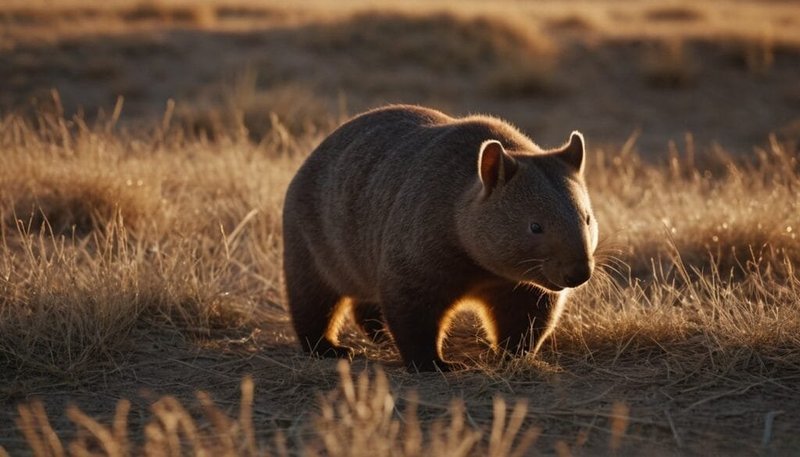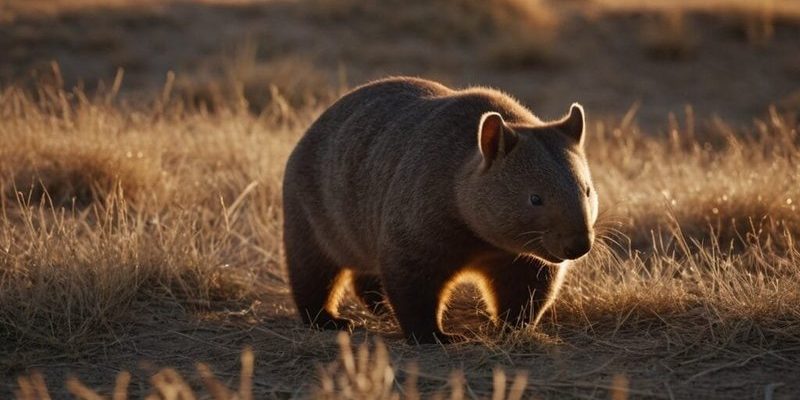
Wombats are herbivores, which means they primarily munch on plants. But don’t let the gentle appearance fool you—these creatures have some clever tricks up their sleeves when it comes to foraging. Their unique dietary needs and foraging strategies have adapted beautifully to their environment, helping them find food even in less-than-ideal situations. Curious yet? Let’s explore their eating habits, how they hunt for food, and why these strategies matter in the wild.
Wombats: A Brief Overview
Before we dive into their diet and hunting strategies, let’s get to know wombats a little better. These chunky marsupials are native to Australia and come in three species: the common wombat, the northern hairy-nosed wombat, and the southern hairy-nosed wombat. With their squat bodies and sturdy legs, they’re built for life on the ground. Think of them as the bulldogs of the marsupial world.
Wombats tend to be nocturnal, which means they’re most active at night. When the sun goes down, they come out to play—and to eat. Their strong legs are perfect for digging, allowing them to create extensive burrow systems. These homes not only provide shelter but also give them easy access to their favorite foods.
The Herbivore Lifestyle
Wombats are strict herbivores, and their diet mainly consists of grasses, roots, and leaves. One of their favorite snacks is tough, fibrous plants like native grasses and sedges. They aren’t picky eaters, though; they’ll munch on a variety of plants, which is key to their survival in the wild.
Here’s the thing: the plant-based diet of wombats does present some challenges. Many plants in their environment are low in nutrients, so wombats have developed a unique digestive system that helps them get the most out of their food. They have a slow digestive process that can take up to two weeks! This means they can extract every bit of goodness from their meals.
As they graze, wombats use their powerful incisors to clip grass and other vegetation. They’ll carefully select the best parts of the plant, ensuring they’re getting enough nutrition to sustain their energy levels. This meticulous approach to eating is a survival tactic; by choosing nutrient-rich plants, they can thrive in their sometimes harsh surroundings.
Foraging Strategies
So, how do wombats actually find their food? Foraging is a key part of their daily routine, and they have some interesting strategies. They tend to stick to the same areas where food is plentiful. This might seem overly simple, but it’s actually a smart move.
Wombats rely on their excellent sense of smell and keen eyesight to locate food. They can sniff out fresh greenery from quite a distance, which helps them locate tasty patches to munch on. Being nocturnal, they often eat under the cover of darkness, which helps them avoid predators.
Another fun fact? Wombats are efficient grazers. They often return to the same feeding areas, which helps them monitor their food sources. By eating selectively and managing their territory, they ensure that there’s always enough food available, even in the lean months. It’s all about strategy and patience.
Burrowing: A Food Storage Strategy
You might be wondering how burrowing fits into the diet and hunting strategies of wombats. Well, burrowing isn’t just for shelter; it’s also a critical strategy for accessing food. Wombats dig extensive burrows that can stretch over 100 meters (about 328 feet) underground. This provides them with a safe place to retreat while also keeping them close to their food sources.
By creating these tunnels, wombats can access roots and other underground plants that other animals might miss. This gives them an edge when competition for food is tight. Their burrows also help regulate temperature, keeping them cool during the hot Australian days and warm at night.
Not only that, but wombats have been known to use their burrows as a sort of food stash. The cool, dark environment helps preserve any leftover plant material they find, making it accessible for later snacking. Talk about a smart meal prep strategy!
Seasonal Changes and Adaptations
Now, diets aren’t static, and wombats are no exception. As seasons change, so does their food availability. During dry periods, it can be harder for wombats to find fresh greens. To adapt, they may widen their foraging areas or look for different types of vegetation that can thrive in tougher conditions.
In the wetter months, however, their diet becomes a buffet of delicious plant life. They might consume more succulent grasses and even explore newly sprouted plants. They have a knack for capitalizing on seasonal changes, which is vital for their survival.
It’s fascinating how these marsupials are in tune with their environment. Their ability to adapt their diet based on food availability shows their resilience and resourcefulness. Understanding these seasonal shifts helps researchers protect wombat habitats and ensure they have enough to eat all year long.
The Importance of Conservation
Wombats face threats like habitat loss, climate change, and disease. Protecting their environment and ensuring a steady supply of food is critical for their survival. Conservation efforts are essential not just for wombats, but for the entire ecosystem they inhabit.
Maintaining natural habitats means that wombats can continue their unique foraging habits and thrive in the wild. This is important not only for wombats but also for the health of the overall ecosystem, as they play a role in soil aeration and nutrient cycling through their grazing and burrowing activities.
By raising awareness about their dietary needs and hunting strategies, we can better advocate for the protection of wombats and their habitats. Every bit of knowledge helps in the fight against their decline, ensuring that future generations get to enjoy these remarkable creatures.
Wombats are truly remarkable animals with a diet and hunting strategy that reflect their adaptability and cleverness. By understanding what they eat and how they find food, we gain insight into their world and the importance of protecting their habitats. These lovable marsupials remind us of nature’s complexity and the delicate balance that keeps ecosystems thriving.
So, the next time you think about wombats, remember—there’s more to their story than just their cuteness. They’re survivors with a plan, making the most of their environment, and that’s something worth celebrating! Let’s make sure we do our part in protecting these fascinating creatures for years to come.

